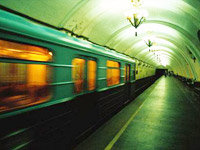Winter air to cool off Moscow metro in summer
The air in the metro is swarming with microbes and germs
The Moscow metro is bad for people's health in spite of the fact that it is  considered the most beautiful metro in the world. However, the less time people spend there, the better, a study by the State Committee for Sanitation and Epidemic Supervision showed. A rush-hour ride on the metro normally entails a highly unpleasant experience featuring stuffy air and sweltering bodies packed like sardines. More than 50 thousand metro passengers seek medical help every year. The metro ventilation system is to blame, Strana.Ru wrote.
considered the most beautiful metro in the world. However, the less time people spend there, the better, a study by the State Committee for Sanitation and Epidemic Supervision showed. A rush-hour ride on the metro normally entails a highly unpleasant experience featuring stuffy air and sweltering bodies packed like sardines. More than 50 thousand metro passengers seek medical help every year. The metro ventilation system is to blame, Strana.Ru wrote.
“The metro is ventilated by shafts that let in air from above the ground. The air is cooled off in summer and heated in winter as it passes through the tunnels because of the heat-retaining properties of the soil around the tunnel walls. The tunnel walls (made either of cast iron or concrete) retain the heat in summer while they release it in winter,” said Igor Lobanov, the head of Electrical and Mechanical Service of the Moscow Metro.
Metro carriages are ventilated by means of ventilation ducts located beneath the  carriages' windows. Passengers may be in real trouble should the train suddenly grind to a halt and the air circulation stops altogether. However, there is some good news about the carriages.
carriages' windows. Passengers may be in real trouble should the train suddenly grind to a halt and the air circulation stops altogether. However, there is some good news about the carriages.
“Unlike the rolling stock manufactured until recently, the new carriage models Yauza and Rusich are now equipped with a compulsory ventilation system. Besides, the Rusich carriages are equipped with a heating system to keep the passengers warm while traveling above the ground,” said Mr. Lobanov.
Another major concern has to do with environment. The ventilation ducts for downtown metro stations open directly into some of the city's biggest streets which are clogged with traffic. The findings of the study confirms that gases such as nitrogen dioxide, carbon dioxide as well as dust, noise and plain old grime exceed permissible levels in dozens of metro stations.
It is quite possible to take effective steps against the air pollution in the metro. Using special ionizers could improve the situation to a certain extant. Sanitation authorities of the metro have already begun working on the problem. However, ionizers installed in a passageway between the circular and radial platforms of the Paveletskaya station failed to produce the effect as planned. The equipment will be back in operation after the necessary adjustments are completed by authorized personnel.
 There is yet another serious environmental problem the metro has to tackle. The air in the metro is swarming with microbes and germs. Microorganisms feel excellent developing within the confines of microclimate. Besides, new varieties regularly join the decease-spreading community thanks to homeless people. The metro sanitation authorities have been disinfecting all metro trains against the pathogens of flu, hepatitis, and tuberculosis since the fall of 2003. The authorities made some progress. There was no epidemic of hepatitis or TB in the metro. The flu seems to be the hardest enemy to fight off. “We can effectively improve microclimate in the metro by enlarging the length of the metro network (building new metro lines and stations) in accordance with the norms. We are presently short of nearly 100 km of the new lines,” said Igor Lobanov.
There is yet another serious environmental problem the metro has to tackle. The air in the metro is swarming with microbes and germs. Microorganisms feel excellent developing within the confines of microclimate. Besides, new varieties regularly join the decease-spreading community thanks to homeless people. The metro sanitation authorities have been disinfecting all metro trains against the pathogens of flu, hepatitis, and tuberculosis since the fall of 2003. The authorities made some progress. There was no epidemic of hepatitis or TB in the metro. The flu seems to be the hardest enemy to fight off. “We can effectively improve microclimate in the metro by enlarging the length of the metro network (building new metro lines and stations) in accordance with the norms. We are presently short of nearly 100 km of the new lines,” said Igor Lobanov.
Subscribe to Pravda.Ru Telegram channel, Facebook, RSS!





